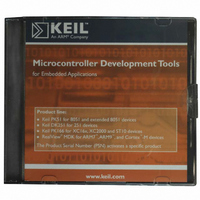MDK-ARM Keil, MDK-ARM Datasheet - Page 104

MDK-ARM
Manufacturer Part Number
MDK-ARM
Description
KIT REALVIEW MCU DEVELOPMENT
Manufacturer
Keil
Type
Compiler and IDEr
Specifications of MDK-ARM
For Use With/related Products
ARM MCUs
Lead Free Status / RoHS Status
Lead free / RoHS Compliant
- Current page: 104 of 156
- Download datasheet (3Mb)
104
Once the data has been written into the packet, we can use udp_send() to transmit
it. When we call the udp_send() function, we must pass the socket handle, the
remote IP address, the remote port, the buffer pointer and the data packet size.
This will cause RL-TCPnet to send the frame. The UDP protocol is a “best
effort” protocol. This means that once the packet is sent there is no
acknowledgement or handshake from the destination station. If you require a
positive acknowledgement that the packet was received, then the destination
station must send a reply UDP frame.
U16 udp_callback (U8 soc, U8 *rip, U16 rport, U8 *buf, U16 len)
}
To receive the UDP data packets the destination station must make the same “get
socket” and “port open” calls. This will ensure that it is listening for the UDP
packet. When a packet arrives, it is processed by the RL-TCPnet and the
udp_callback() function is triggered. This function receives the local socket
handle, the remote IP address, and the port number of the sending station. It also
receives a pointer to the received data along with the number of bytes received.
The destination station can then reply back to the source station using its IP
address and port number.
Exercise: UDP Sockets
This exercise demonstrates peer-to-peer communication between two evaluation
boards using the UDP protocol.
if (soc == socket_udp)
}
return (0);
Process_packet (buf,len);
{
Chapter 4. RL-TCPnet Introduction
{
Related parts for MDK-ARM
Image
Part Number
Description
Manufacturer
Datasheet
Request
R

Part Number:
Description:
KIT REALVIEW MCU DEVELOPMENT
Manufacturer:
Keil
Datasheet:

Part Number:
Description:
Development Software SUPPORT EXTENSION FOR MDK-ARM-B
Manufacturer:
Keil Software

Part Number:
Description:
Development Software SUPPORT EXTENSION FOR MDK-ARM
Manufacturer:
Keil Software

Part Number:
Description:
KIT REALVIEW MCU DEVELOPMENT
Manufacturer:
Keil
Datasheet:

Part Number:
Description:
Development Software MCU DEV KIT FOR ARM UPG TO FLOATING LIC
Manufacturer:
Keil Tools

Part Number:
Description:
Development Software MCU DEV KIT FOR ARM W/ FLOATING LICENSE
Manufacturer:
Keil Software

Part Number:
Description:
Development Software MCU DEV KIT FOR ARM uVISION & C++ & RTX
Manufacturer:
Keil Tools

Part Number:
Description:
Development Software SUPP LICENSE RENEWAL 90+ DAYS NO TECH SUP
Manufacturer:
Keil Software
Part Number:
Description:
KEIL C-COMPILER INTERNATIONAL
Manufacturer:
Silicon Laboratories Inc

Part Number:
Description:
BOARD EVAL FOR LPC213X ARM MCU
Manufacturer:
NXP Semiconductors
Datasheet:
Part Number:
Description:
K60N512 Keil Tower Kit
Manufacturer:
Freescale Semiconductor
Datasheet:










